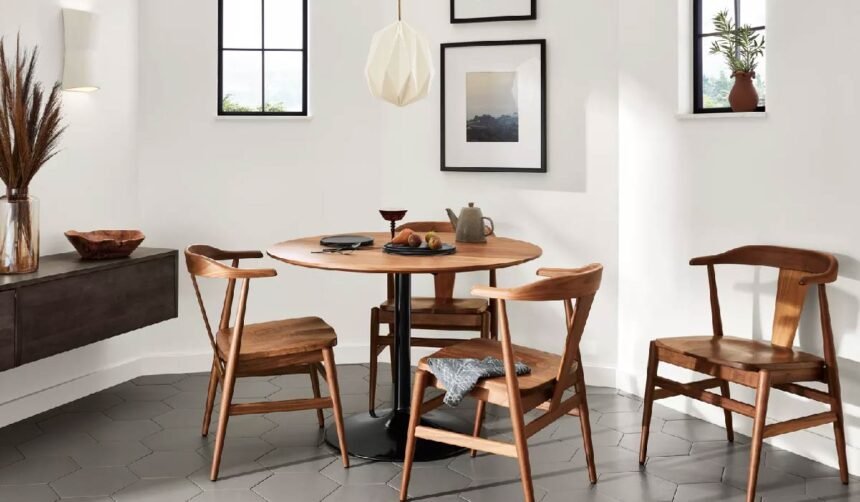Choosing the right dining table for your home is one of the most important decisions when setting up a dining space. The dining table is the central piece of furniture where families gather, meals are shared, and guests are entertained. Selecting the right size is not only about how many people you want to seat but also about balancing style, proportion, and functionality within the room. This guide will help you determine the ideal dining table size for your space, whether you are designing a large openplan dining area or working with a smaller room.
Why Dining Table Size Matters
A dining table that is too large can make a room feel cramped, while one that is too small may leave the space looking incomplete and unable to accommodate guests comfortably. The right table should allow for sufficient walking space around it, provide enough elbow room for each diner, and match the overall design aesthetic of your home. Since dining rooms often serve multiple purposes today, such as working from home or hosting celebrations, the choice of size and shape should enhance practicality while maintaining elegance.
Measuring Your Dining Room
Before you begin browsing styles, take accurate measurements of your dining room. Start with the length and width of the area and note the placement of windows, doors, or architectural features such as fireplaces. Leave at least 36 inches of clearance space between the table edge and the nearest wall or furniture so that chairs can be pulled out comfortably. If the room is part of an openplan living space, visualize traffic flow between different areas to ensure the dining table does not disrupt movement.
A simple method to test the size is to use masking tape on the floor to mark the dimensions of a potential table. Place chairs within the taped outline and move around to see how the arrangement feels. This handson approach will give you a better understanding of scale before committing to a purchase.
Standard Dining Table Dimensions
Dining tables come in a variety of shapes, each with standard dimensions that provide guidance when planning your space.
Rectangular Tables
Rectangular tables are the most common choice because they fit well into both formal dining rooms and casual spaces. A table measuring 72 inches long typically seats six people, while 96 inches accommodates eight, and 120 inches can seat ten to twelve comfortably. The standard width ranges between 36 to 42 inches, which allows sufficient space for place settings and serving dishes in the middle.
Square Tables
Square tables work well in square rooms or openplan layouts where symmetry is desired. A 36inch square table seats four, while a 60inch square can seat up to eight. The larger options often have a more modern appeal and encourage intimacy since everyone is at equal distance from one another.
Round Tables
Round tables are perfect for creating a cozy and conversational dining experience. A 48inch round table comfortably seats four, while a 60inch version accommodates six, and 72 inches can seat up to eight people. Round tables also eliminate sharp corners, making them a safer choice in households with children. However, larger round tables can sometimes make it difficult to pass food across the surface, which is why a lazy Susan is a popular addition.
Oval Tables
Oval tables combine the benefits of rectangular and round designs. They seat more people than round tables of a similar width but maintain a softer, flowing shape that works well in both traditional and contemporary interiors. A typical oval dining table measuring 84 inches in length will seat six to eight guests comfortably.
Allowing Elbow Room and Comfort
Beyond fitting the table into the space, it is essential to allow enough room for each person at the table. The standard width per person is around 24 inches, though 30 inches is preferable for a more relaxed setting. This ensures guests are not bumping elbows and can enjoy meals with ease. For formal dining, a bit more space per person enhances comfort, especially when using larger place settings.
Height Considerations
The standard dining table height is around 28 to 30 inches, which works well with most chair heights. Counterheight dining tables stand taller at 34 to 36 inches and are often paired with stools, while barheight options are even higher. When selecting a table, always ensure the chairs provide enough legroom for comfort. If you are purchasing modern dining table and chairs sets together, the proportions will already be matched, saving you the worry of incompatibility.
Choosing the Right Shape for Your Room
The shape of the dining table should complement the room’s architecture and enhance the overall flow.
- Rectangular rooms benefit most from rectangular tables since they emphasize the length of the room.
- Square rooms pair well with square or round tables for balanced proportions.
- Small spaces are better suited to round or oval tables since the curved edges create a sense of openness.
If flexibility is important, consider extendable tables that can be expanded when entertaining guests and reduced to save space on a daily basis.
Material and Style Considerations
Once you have determined the correct size and shape, the next step is to select the material and style. Wooden tables remain timeless, offering warmth and durability, while glass tables add lightness and a sense of space in smaller rooms. Metal and stone tops provide modern appeal and durability.
Matching the table with complementary seating is just as important. Purchasing modern dining table and chair sets ensures a cohesive look and allows you to select designs that reflect your style, whether it is sleek minimalism, rustic charm, or luxurious elegance.
Additional Features to Consider
Extendable Tables
Extendable dining tables are highly practical for households that host gatherings occasionally. They allow you to save space during daily use while accommodating more guests when needed.
Storage Options
Some tables come with builtin storage or shelving, perfect for keeping dining essentials like cutlery or linens within easy reach.
Easy Maintenance
Think about how much upkeep the material will require. Glass tops may need frequent cleaning, while solid wood may require polishing to maintain its finish.
Tips for Small Dining Rooms
For compact dining rooms, select tables with slimmer legs or pedestal bases to maximize legroom. Round tables often make the best use of limited space, and opting for transparent materials like glass can create the illusion of openness. Pairing with slim, armless chairs also saves space.
Tips for Large Dining Rooms
In larger spaces, do not be afraid to choose a statement table that anchors the room. Long rectangular or oval tables work beautifully, and adding upholstered chairs or benches can enhance comfort while filling the space proportionally. Consider placing a chandelier or pendant light above the table to highlight it as the focal point of the room.
Conclusion
Finding the perfect dining table size requires balancing the dimensions of your room, the number of guests you wish to accommodate, and the style you want to achieve. By measuring carefully, considering the shape of your space, and evaluating seating comfort, you can select a table that enhances both function and aesthetics. For those looking to upgrade, Furniture in Fashion offers a wide selection of dining tables and complementary furniture that cater to every style and budget. Whether you are furnishing a small apartment or a spacious home, you will find quality designs that bring elegance and practicality to your dining room.









